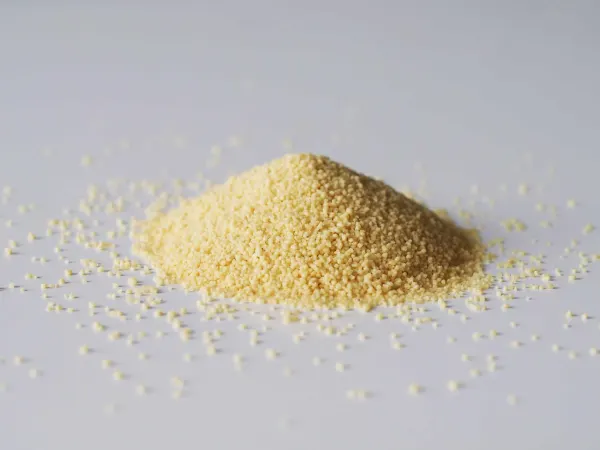Access our First Foods® Database in the Solid Starts App.
Learn moreCouscous
Grain
Age Suggestion
6 months
Iron-Rich
No
Common Allergen
Yes

When can babies eat couscous?
Couscous may be introduced as soon as baby is ready to start solids, which is generally around 6 months of age. If you haven’t already introduced wheat, start with a scant amount of couscous at the start, as couscous often contains wheat, a common food allergen in children.
How to serve couscous for babies with baby-led weaning?
Every baby develops on their own timeline, and the suggestions on how to cut or prepare particular foods are generalizations for a broad audience.
6 to 12 months old:
Serve couscous alongside soft foods like mashed fruits or cooked vegetables, legumes, unsweetened yogurt, or your favorite tagine recipe so the tiny beads more easily cling to hands. When serving couscous, it is a good idea to offer water from a cup or straw to ensure that the mouth is empty after the meal, as the small pieces of couscous could easily be left behind. Finally, serve couscous on a day when you have the energy for a clean-up, as couscous tends to wind up everywhere when baby digs in.
12 to 24 months old:
Time for utensils! Continue to serve couscous with soft, scoopable foods that it can bind to and try offering a fork, a spoon, or a utensil of choice for baby to practice. Don’t worry if a toddler is not interested in using a utensil and wants to continue scooping with hands. Eating couscous with hands is traditional in some cultures, plus learning to use utensils can be exhausting for new eaters and many toddlers go back and forth feeding with fingers and utensils. Try not to apply too much pressure—consistent and accurate utensil use will come in due time—probably between 18 and 24 months of age.
For more information on how to cut food for babies, visit our page on Food Sizes & Shapes.
Videos
Is couscous a common choking hazard for babies?
It can be. Couscous is not a common choking hazard though the larger pearl-size varieties, including Lebanese moghrabieh can be. (Israeli pearl style couscous should be fine.) As always, make sure you create a safe eating environment, stay within arm’s reach of your baby during meals, and check out our age-appropriate serving suggestions.
For more information, visit our section on gagging and choking and familiarize yourself with common choking hazards.
Is couscous a common allergen?
Yes. Couscous is often made of wheat, which is one of the most common food allergens in children. Fortunately, two-thirds of children outgrow the allergy by their 12th birthday. Individuals with Oral Allergy Syndrome (also known as pollen food allergy syndrome) may be sensitive to wheat, particularly those who are allergic to grass pollen. Oral Allergy Syndrome typically results in short-lived itching in the mouth. It is unlikely to result in a dangerous reaction.
While rare, some individuals have a condition known as wheat-dependent, exercise-induced anaphylaxis, which can result in a severe allergic reaction if the person exercises within a few hours after eating wheat. These patients should avoid eating wheat in the four hours before strenuous activity.
It is important to note that wheat allergy is not the same as celiac disease. While a wheat allergy may be outgrown, celiac disease requires a strict, lifelong gluten-free diet and lifestyle. A gluten “allergy” is typically a misnomer, often in reference to celiac disease.
If your baby has a family history of allergies, or you suspect your baby is allergic to wheat, talk to a pediatric health care provider before introducing couscous at home. As you would when introducing any new food, start by offering a small quantity for the first couple of servings and watch closely for any signs of an allergic reaction. If there is no adverse reaction, gradually increase the amount over future servings.
Is couscous healthy for babies?
Yes, when consumed as part of a balanced diet. Couscous offers plenty of carbohydrates to energize a baby’s growing body. Vitamins and minerals vary based on the kind of grain used to make couscous, with whole grain and enriched grains offering more fiber, protein, and other essential nutrients like iron. Aim to serve couscous as a part of a nutritious and balanced meal, ideally with cooked vegetables and protein from meat, seafood, or legumes and experiment with cooking couscous in different liquids like milk, meat stock, or vegetable broth to increase flavor and nutrition. Check out our age-appropriate serving suggestions.
★Tip: Choose organic couscous when budget and access allow for it—or opt for alternative grains like amaranth, buckwheat, Khorasan wheat, or quinoa. Couscous made with conventionally-grown wheat that is commonly sprayed with pesticides that can negatively impact human and environmental health.
Background and origins of couscous
Couscous are tiny beads of dough made with semolina, the same type of nutrient-rich wheat that gives pasta its shape and texture. The name comes from North and West Africa, where the staple food is traditionally hand-rolled and served alongside sweet and savory soups and stews at breakfast, lunch, and dinner. For those short on time, instant couscous can be prepared quickly—sometimes in less than 5 minutes. There are lots of different styles to try, such as Palestinian maftoul made with bulgur; the garden pea-sized moghrabieh of Lebanese cooking; handmade and toasted Sardinian fregola, Senagalese thiéré made of millet, and p’titim, a beloved pearled variety in Jewish cooking that is commonly called Israeli couscous in the United States.
★Tip: Brace for mess! Couscous is notoriously messy when it comes to babies. Serve couscous on a day you can get a bit messy.
Can babies eat gluten?
Yes—as long as a child does not have wheat allergy, non-celiac gluten sensitivity, or celiac disease. Gluten is simply a type of protein in wheat and other grains such as barley, rye, and some oats. Gluten is edible, but it becomes problematic for individuals with celiac disease, an autoimmune disease, characterized by damage of the small intestine when gluten is consumed. Some individuals may be sensitive to gluten, but may not have a wheat allergy or celiac disease. In some cases, this may be non-celiac gluten sensitivity. However, gluten-containing grains can also contain certain carbohydrates that are difficult for some individuals to digest.
Our Team
Written by
Expert Tips Delivered to Your Inbox
Sign up for weekly tips, recipes and more!







